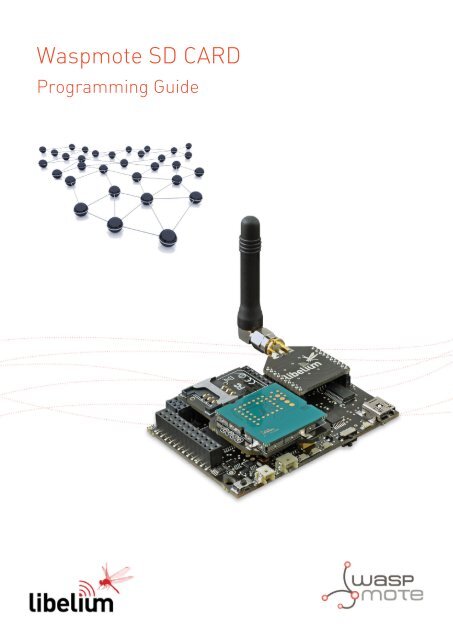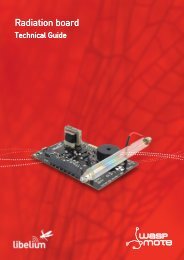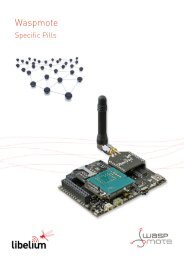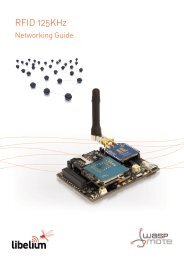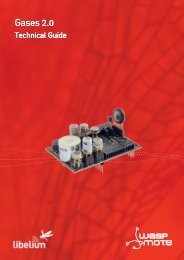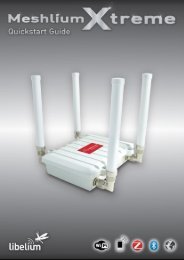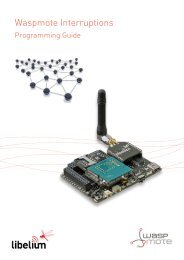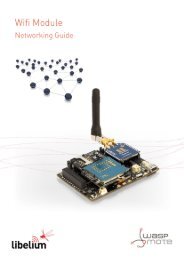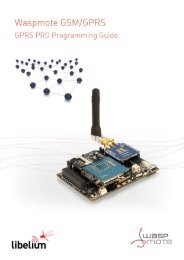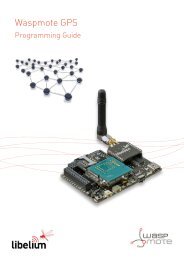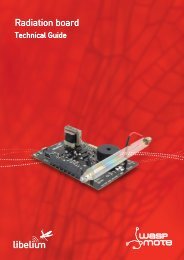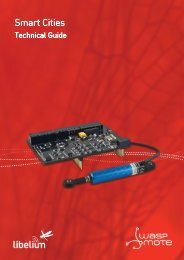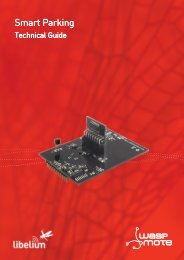Waspmote SD CARD - Libelium
Waspmote SD CARD - Libelium
Waspmote SD CARD - Libelium
- No tags were found...
Create successful ePaper yourself
Turn your PDF publications into a flip-book with our unique Google optimized e-Paper software.
<strong>Waspmote</strong> <strong>SD</strong> <strong>CARD</strong>Programming Guide
IndexDocument Version: v4.6 - 11/2014© <strong>Libelium</strong> Comunicaciones Distribuidas S.L.INDEX1. General Considerations........................................................................................................................ 41.1. <strong>Waspmote</strong> Libraries......................................................................................................................................................................41.1.1. <strong>Waspmote</strong> <strong>SD</strong> Files........................................................................................................................................................41.1.2. Constructor......................................................................................................................................................................41.1.3. Flag.....................................................................................................................................................................................41.1.4. Error Messages...............................................................................................................................................................51.1.5. Buffer.................................................................................................................................................................................51.2. Formatting <strong>SD</strong> Card......................................................................................................................................................................51.3. Short filename format.................................................................................................................................................................52. Initialization.......................................................................................................................................... 62.1. Initializing a Card...........................................................................................................................................................................62.2. Closing a Card................................................................................................................................................................................62.3. <strong>SD</strong> Present........................................................................................................................................................................................63. Disk Operations.................................................................................................................................... 73.1. Disk Information............................................................................................................................................................................73.2. Disk Size............................................................................................................................................................................................74. Directory Operations............................................................................................................................ 84.1. Creating a Directory ....................................................................................................................................................................84.2. Deleting a Directory ....................................................................................................................................................................84.3. Directory Listing ...........................................................................................................................................................................94.4. Finding a Directory ...................................................................................................................................................................104.5. Number of files ..........................................................................................................................................................................104.6. Changing Directory ..................................................................................................................................................................115. File Operations.................................................................................................................................... 125.1. Creating Files...............................................................................................................................................................................125.2. Deleting Files...............................................................................................................................................................................125.3. Opening Files...............................................................................................................................................................................135.4. Closing Files.................................................................................................................................................................................135.5. Finding Files.................................................................................................................................................................................145.6. Reading data................................................................................................................................................................................145.7. Writing Data.................................................................................................................................................................................145.8. Number of Lines.........................................................................................................................................................................155.9. Getting File Size..........................................................................................................................................................................155.10. Finding Patterns.......................................................................................................................................................................16-2- v4.6
Index6. Code examples and extended information...................................................................................... 177. API changelog..................................................................................................................................... 188. Documentation changelog................................................................................................................ 19-3- v4.6
General ConsiderationsNote: There are many <strong>SD</strong> card models. Any of them has defective blocks, which are ignored when using the <strong>Waspmote</strong>’s <strong>SD</strong>library. However, when using OTA, those <strong>SD</strong> blocks cannot be avoided, so that the execution could crash. <strong>Libelium</strong> implements aspecial process to ensure the <strong>SD</strong> cards we provide will work fine with OTA. The only <strong>SD</strong> cards that <strong>Libelium</strong> can assure that workcorrectly with <strong>Waspmote</strong> are the <strong>SD</strong> cards we distribute officially.Note: Make sure <strong>Waspmote</strong> is switched off before inserting or removing the <strong>SD</strong> card. Otherwise, the <strong>SD</strong> card could be damaged.Note: <strong>Waspmote</strong> must not be switched off or reseted while there are ongoing read or write operations in the <strong>SD</strong> card. Otherwise,the <strong>SD</strong> card could be damaged and data could be lost. If you suspect that there may be some ongoing <strong>SD</strong> operations, wait awhile until they are completed.Tip: you can use one programmable LED to signal when the <strong>SD</strong> card is being processed.1. General Considerations1.1. <strong>Waspmote</strong> Libraries1.1.1. <strong>Waspmote</strong> <strong>SD</strong> FilesWasp<strong>SD</strong>.h ; Wasp<strong>SD</strong>.cppOther utilities inside the sd_utilities subdirectory: ufstream.h, ostream.cpp, SdBaseFile.h, SdFile.cpp, SdSpi.h , ios.h, ostream.h,SdFatConfig.h, SdFile.h, SdStream.cpp , iostream.h, Sd2Card.cpp, SdFat.cpp, SdInfo.h, SdStream.h , istream.cpp, Sd2Card.h,SdFat.h, SdSpiArduino.cpp, SdVolume.cpp , istream.h, SdBaseFile.cpp, SdFatStructs.h, SdSpiAVR.cpp, SdVolume.h1.1.2. ConstructorTo start using <strong>Waspmote</strong> <strong>SD</strong> library, an object from class ‘Wasp<strong>SD</strong>’ must be created. This object, called ‘<strong>SD</strong>’, is created inside<strong>Waspmote</strong> <strong>SD</strong> library and it is public to all libraries. It is used through the guide to show how <strong>Waspmote</strong> <strong>SD</strong> library works.When creating this constructor, no variables are initialized by default.1.1.3. FlagA flag to indicate if there have been any problem during execution of a function has been created. This flag shows the state ofthe <strong>SD</strong> card during initialization and operation. Possible values are:••0 : nothing failed, all processes have been executed properly.••1 : no <strong>SD</strong> card in the slot.••2 : initialization failed.••4 : volume partition failed.••8 : root failed.••16 : truncated data. Data length is bigger than buffer length, so data will be truncated to fit the buffer.••32 : error when opening a file.••64 : error when creating a file.••128 : error when creating a directory.••256 : error when writing to a file.-4- v4.6
General Considerations1.1.4. Error MessagesWhen executing some functions, a string is returned explaining the state of <strong>SD</strong> card. Possible messages are:••“no <strong>SD</strong>” : <strong>SD</strong> has not been found in the card slot••“Invalid filename”: An invalid name for a file or a directory. It must respect the “8.3 filename” format (also called “shortfilename” or “SFN”)1.1.5. BufferDue to memory restrictions, a buffer has been created to limit the length of the data managed by <strong>Waspmote</strong> API librarieswhen working with <strong>SD</strong> cards. Buffer size has been set to 256Bytes due to it is a sufficient value to manage strings and itoccupies little memory.This limit must be considered when developing applications, using the flag previously explained to know when data has beentruncated. Obviously this does not mean you can handle 256B only, but you have to make writings and readings of this size.1.2. Formatting <strong>SD</strong> CardWhen formatting the <strong>SD</strong> card before starting using <strong>Waspmote</strong>, there are some considerations to have in mind. The mostimportant matter to know before formatting an <strong>SD</strong> card is setting the right size of the allocation tables to address the cardproperly. Despite of selecting FAT16, when formatting the card if there is no indication, the OS will select a size between 12,16and 32 bits. The right value is 16b.1.3. Short filename formatAn 8.3 filename (also called a short filename or SFN) is a filename convention which is followed by the <strong>SD</strong> card library. 8.3 filenameshave at most eight characters, optionally followed by a “.” character and a filename extension of at most three characters.Only upper-case letters A–Z are valid. When using lower-case letters a-z, these are converted to upper-case letter.Besides, illegal characters for directories and filenames include the following:| < > ^ + = ? / [ ] ; , * \ “ \ \Example of valid and invalid filenames:FILE.TXTFILENAMEFILENAME.TXTFOLDERSUBFOLDER→ valid→ valid→ valid→ valid→ invalid (more than 8 characters)FILENAME1.TXT → invalid (more than 8 characters before ‘.’)FILENAME.AAAA → invalid (more than 3 characters after ‘.’)file.txt→ valid (but it will be interpreted as FILE.TXT)-5- v4.6
Initialization2. InitializationBefore start using the <strong>SD</strong> card, it needs to be initialized. This process checks if an <strong>SD</strong> card is present on the slot, initializes SPI bus,opens partition and opens root directory.2.1. Initializing a CardThe following function checks if an <strong>SD</strong> card is present in the slot, sets the microcontroller pin which powers the <strong>SD</strong> card up,initializes the SPI bus, opens the FAT volume partition and opens the root directory. It returns nothing but it updates the flagwith an error code indicating the possible error messages.Example of use{}<strong>SD</strong>.ON(); // Set <strong>SD</strong> card onAvailable Information<strong>SD</strong>.flag → stores the error code indicating the state of <strong>SD</strong> initialization process.The <strong>SD</strong> card cannot be removed or inserted without powering off <strong>Waspmote</strong>. If a <strong>SD</strong> card is removed, the initialization functionshould be called to initialize the card again. Before that, the <strong>SD</strong> Card should be closed using functions explained in section“Closing a card”.2.2. Closing a CardCloses the root directory and the SPI bus. It also switches off the microcontroller pin that powers the <strong>SD</strong> card. It returns nothingand it does not change the flag value.Example of use{}<strong>SD</strong>.OFF(); // Powers <strong>SD</strong> card down2.3. <strong>SD</strong> PresentIt reads the associated pin to know if there is an <strong>SD</strong> in card slot.It returns ‘1’ if <strong>SD</strong> card is present and ‘0’ if not.If <strong>SD</strong> is not present, it closes card to avoid problems with pointers.Example of use{}uint8_t present;// Reads associated pin to know if there is a <strong>SD</strong> in card slotpresent=<strong>SD</strong>.is<strong>SD</strong>();Available Informationpresent→ stores ‘1’ if <strong>SD</strong> card is detected and ‘0’ if not.-6- v4.6
Disk Operations3. Disk OperationsWhen <strong>SD</strong> has been initialized properly, pointers can be used to access partition, file system and root directory. There are somefunctions that return information about the <strong>SD</strong> card.3.1. Disk InformationStores all the data containing the disk info into the buffer. It returns a filled buffer if success on getting disk info and an emptystring if not.Example of use{// Gets disk info, returning it and storing this info in ‘<strong>SD</strong>.buffer’<strong>SD</strong>.print_disk_info();USB.println(<strong>SD</strong>.buffer);}Available Information<strong>SD</strong>.buffer → stores the data received as a human-readable encoded string.diskInfo → pointer to <strong>SD</strong>.bufferAn example of the output by this system would be:manuf: 0x1boem: SMprod: 21e7rev: 1.0serial: 0xedb6c604date: 11/103.2. Disk SizeGets the total size of the <strong>SD</strong> card.It returns ‘diskSize’ variable and updates its value. Size is stored and returned in Bytes.Example of use{// Get total size of <strong>SD</strong> carddiskSize = <strong>SD</strong>.getDiskSize();USB.println(<strong>SD</strong>.diskSize);}Related Variables<strong>SD</strong>.diskSize → stores the total size of the <strong>SD</strong> card.An example of the value would be: <strong>SD</strong>.diskSize=992608256-7- v4.6
Directory Operations4. Directory OperationsTo organize an <strong>SD</strong> card, it is possible to create and manage directories. There are some functions related with directories.4.1. Creating a DirectoryIt creates a directory given as a valid directory path (according to short filename format) in the current working directory. Theroot directory is the default directory each time <strong>SD</strong> card is initialized.It returns ‘1’ on creation and ‘0’ on error, activating the flag too.If a directory name already exists, it will occur an error and the flag will be activated.Example of use{boolean dirCreation;char* name = ”FOLDER1”;char* path = ”FOLDER3/FOLDER4/FOLDER5”;// creates a directory in the current directory called “FOLDER1”dirCreation = <strong>SD</strong>.mkdir(name);// creates a directory in the current directory called “FOLDER2”dirCreation = <strong>SD</strong>.mkdir(“FOLDER2”);}// creates a three-directory path in the current directorydirCreation = <strong>SD</strong>.mkdir(path);• Creating and deleting directories example:http://www.libelium.com/development/waspmote/examples/sd-05-create-delete-directoriesNote 1: All directory names must be defined according to 8.3 short filename format (see section “Short filename format”)Note 2: Be careful when calling this function to create a directory. If it is interrupted, the directory results damaged and it is necessaryto delete it as a regular file using <strong>SD</strong>.del4.2. Deleting a DirectoryEmpty directoriesThe directory file will be removed only if it is empty and is not the root directory.It returns ‘1’ if the directory has been erased properly and ‘0’ if error.Note: It allows erasing a complete path of directories always they are empty.Example of use{const char* name=”FOLDER”;char* path=”FOLDER3/FOLDER4/FOLDER5”;uint8_t delState;// deletes the directory in the current directory called “FOLDER”delState = <strong>SD</strong>.rmdir(name);-8- v4.6
Directory Operations//deletes the directory in the current directory called “FOLDER2”delState = <strong>SD</strong>.rmdir (“FOLDER2”);}//deletes a three-empty-directory path in the current directorydirCreation = <strong>SD</strong>.rmdir(path);• Creating and deleting directories example:http://www.libelium.com/development/waspmote/examples/sd-05-create-delete-directoriesNon-empty directoriesIt is possible to delete a directory and all contained files. It returns ‘1’ if the directory has been erased properly and ‘0’ if error.Example of use{const char* name = ”FOLDER”;char* path = ”FOLDER3/FOLDER4/FOLDER5”;boolean delState;// deletes the directory in the current directory called “FOLDER”delState = <strong>SD</strong>.rmRfDir(name);// deletes the directory in the current directory called “FOLDER2”delState = <strong>SD</strong>.rmRfDir (“FOLDER2”);}// deletes a three-directory path in the current directorydirCreation = <strong>SD</strong>.rmRfDir (“FOLDER3”);4.3. Directory ListingPrints through the USB port the contents of the current working directory. It is possible to introduce three different flags whichmay be an inclusive OR of:LS_DATE - Print file modification dateLS_SIZE - Print file size.LS_R - Recursive list of subdirectories.It returns nothing. The information is printed through the USB port.Example of use{// lists the name of all the files of the directory indicating the size of the files<strong>SD</strong>.ls();// lists the name of all files of the directory indicating the size of the files<strong>SD</strong>.ls(LS_SIZE);// lists the name of all files of the directory indicating the date of the files<strong>SD</strong>.ls(LS_DATE);// lists the name of all files of the directory and all subdirectories<strong>SD</strong>.ls(LS_R);}//lists the name of the files recursively indicating size and date<strong>SD</strong>.ls(LS_R|LS_DATE|LS_SIZE);-9- v4.6
Directory OperationsAn example of the output by <strong>SD</strong>.ls(LS_R|LS_DATE|LS_SIZE); would be:FILE8 1980-01-01 00:00:00 204FILE2 1980-01-01 00:00:00 2754FOLDER/ 2000-01-01 01:00:00SUBFOLD/ 2000-01-01 01:00:00FILE.TXT 2012-06-11 11:58:10 811• Listing directories example:http://www.libelium.com/development/waspmote/examples/sd-06-list-files4.4. Finding a DirectoryIt finds a sub-directory in the current directory. If it exists and it is a directory ‘1’ will be returned, ‘0’ will be returned if it exists butit is not a directory and ‘-1’ will be returned if it does not exist.Example of use{uint8_t isdir;const char* name = ”FOLDER”;// tests existence of “FOLDER” in the current directoryisdir = <strong>SD</strong>.isDir(name);}// tests existence of “FOLDER” in the current directoryisdir = <strong>SD</strong>.isDir(“FOLDER”);4.5. Number of filesIt gets the amount of files and subdirectories in the current directory. It returns the number of files or directories found, or zero ifthere are no files or directories. It does not count ‘.’ and ‘..’ directories, so if there are no directories or files in the current directory,zero will be returned.If an error occurs, a negative number is returned.Example of use{}int8_t numfiles;// returns the number of files in the current directorynumfiles = <strong>SD</strong>.numFiles();-10- v4.6
Directory Operations4.6. Changing DirectoryIt changes the current working directory pointer to the directory given as a parameter. It returns ‘0’ if error, and ‘1’ if not.Note: In root directory it has no sense changing directory to ‘..’, so function will return error when doing that.Example of use{uint8_t cdState;const char* command = ”FOLDER”;// Change to directory specified in ‘command’cdState = <strong>SD</strong>.cd(command);}// Go one directory upcdState = <strong>SD</strong>.cd(“..”);• Change current working directory example:http://www.libelium.com/development/waspmote/examples/sd-08-change-directoriesGo directly to root directoryIt is possible to go to root directory using a simple called ‘goRoot’. It returns ‘1’ when ok, ‘0’ when error.Example of use{uint8_t cdState;// define the directory path to changechar* path = “/FOLD1/FOLD2/FOLD3/FOLD4/FOLD5”;// Change to ‘fold5’ directory specified in ‘path’cdState = <strong>SD</strong>.cd(path);}// Go to root directorycdState = <strong>SD</strong>.goRoot();-11- v4.6
File Operations5. File OperationsTo store data, files can be created and managed. There are some functions related to files operations.5.1. Creating FilesIt creates a file.It returns ‘1’ on file creation and ‘0’ if error and it will mark the flag too.Example of use{const char* name = ”FILE.TXT”;boolean fileCreation;// It creates a file named “FILE.TXT”fileCreation = <strong>SD</strong>.create(name);}// It creates a file named “FILE.TXT”fileCreation = <strong>SD</strong>.create(“FILE.TXT”);• Creating and deleting files example:http://www.libelium.com/development/waspmote/examples/sd-01-create-delete-fileNote 1:All file names must be defined according to 8.3 short filename format (see section “Short filename format”)Note 2: The maximum number of files which can be created in the root directory are 341, while a 2nd level directory can store 1.000+files. Thus, in the case the user needs to create hundreds of files in an <strong>SD</strong> card, it is highly advised to create them inside a 2nd leveldirectory.5.2. Deleting FilesIt deletes a file in the current directory. It returns ‘1’ on file delete and ‘0’ if error.Example of use{const char* name = ”FILE.TXT”;boolean fileDelete;}// It deletes a file named “FILE.TXT”fileDelete = <strong>SD</strong>.del(name);// It deletes previously created file named “FILE.TXT”fileDelete = <strong>SD</strong>.del(“FILE.TXT”);• Creating and deleting files example:http://www.libelium.com/development/waspmote/examples/sd-01-create-delete-file-12- v4.6
File Operations5.3. Opening FilesOpens the filepath if available. It is possible to select a bitwise-inclusive OR of flags from the following list:O_READ - Open for reading.O_WRITE - Open for writing.O_RDWR - Open for reading and writing.O_APPEND - If set, the file offset shall be set to the end of the file prior to each write.O_CREAT - If the file exists, this flag has no effect except as noted under O_EXCL below. Otherwise, the file shall be created.O_EXCL - If O_CREAT and O_EXCL are set, open() shall fail if the file exists.O_SYNC - Synchronous writes.Returns ‘1’ on success, ‘0’ otherwiseExample of use{const char* filepath = ”FILE.TXT”;// declare an SdFile objectSdFile file;}// open “FILE” for reading<strong>SD</strong>.openFile( filepath, &file, O_READ);Note: All file names must be defined according to 8.3 short filename format (see section “Short filename format”)5.4. Closing FilesIt closes the pointer which pointed to the previously defined file.Note: If a file is opened with previous function and it is not closed before using another file function, it will not work properly. Only onefile pointer can be managed at the same time.Example of use{}// previously declared fileSdFile file;// close file, referencing the previously opened file<strong>SD</strong>.closeFile(&file);-13- v4.6
File Operations5.5. Finding FilesIt finds a file path in the current directory.If it exists and it is a file ‘1’ will be returned, ‘0’ will be returned if it exists but it is not a file and ‘-1’ will be returned if it does notexist.Example of use{const char* name = ”FILE.TXT”;int8_t fileFound;// looks for “FILE.TXT” in the current directoryfileFound = <strong>SD</strong>.isFile(name);// looks for “FILE.TXT” in the current directoryfileFound = <strong>SD</strong>.isFile(“FILE.TXT”);}5.6. Reading dataIt dumps into the buffer the amount of bytes/lines indicated in ‘scope’ after ‘offset’ bytes/lines.The information is returned as a string where each one of the characters are printed one after the next, EOL (‘\n’) will beencoded as EOL, and will be accounted as one byte.Note: There is a limitation in size, due to buffer size. If the data read was bigger than that, the function will include the characters “>>”at the end and activate the TRUNCATED_DATA value in the flag. It is recommended to check this value to ensure data integrity.If ‘offset’ or ‘scope’, or both of them, are greater than file size, there will be no error but only possible data will be copied into buffer.Example of use{const char* name=”FILE.TXT”;//It stores in ‘<strong>SD</strong>.buffer’ 17 characters after jumping 3<strong>SD</strong>.cat(name,3,17);//It stores in ‘<strong>SD</strong>.buffer’ 100 characters from the beginning<strong>SD</strong>.cat(name,0,100);}//It stores in ‘<strong>SD</strong>.buffer’ 3 lines after jumping over the 2 first<strong>SD</strong>.catln(name,2,3);• Reading files example:http://www.libelium.com/development/waspmote/examples/sd-04-read-file5.7. Writing DataThere are several forms of writing data to a file:••Indicating the position to start writing. Function ‘<strong>SD</strong>.write<strong>SD</strong>’. It is possible to indicate the amount of bytes to write.••At the end of the file. Function ‘<strong>SD</strong>.append’. It is possible to indicate the amount of bytes to write.••At the end of the file including an EOL character. Function ‘<strong>SD</strong>.appendln’It returns ‘1’ on success and ‘0’ if error.-14- v4.6
File OperationsNote: Due to buffer size, 256Bytes is the limit for writing data into a file at once. If more data needs to be written, it will have to bedivided in blocks of 256Bytes.Example of use{const char* file = ”FILE.TXT”;uint8_t writeState;// It writes “hello” on file at position 0writeState = <strong>SD</strong>.write<strong>SD</strong>(file,”hello”,0);// It writes “hello” on file at position 5writeState = <strong>SD</strong>.write<strong>SD</strong>(file,”hello”,5);// It writes “hel” on file at position 10writeState = <strong>SD</strong>.write<strong>SD</strong>(file,”hello”,10,3);// It writes “hello” at the end of filewriteState = <strong>SD</strong>.append(file,”hello”);// It writes “hel” on file at end of filewriteState = <strong>SD</strong>.append(file,”hello”,3);}// It writes “hello” at end of file with EOLwriteState = <strong>SD</strong>.appendln(file,”hello”);• Writing and appending data examples:http://www.libelium.com/development/waspmote/examples/sd-02-write-filehttp://www.libelium.com/development/waspmote/examples/sd-03-append-filehttp://www.libelium.com/development/waspmote/examples/sd-07-datalogger5.8. Number of LinesIt counts the number of lines in a file.The number of lines are counted as the number of ‘\n’ that are found in a file.It returns the amount of lines and negative value if an error occurred. If there are no lines in file selected, zero will be returned.Example of use{const char* name = ”FILE.TXT”;int32_t numberLines;// counts number of lines in file named “FILE.TXT”numberLines = <strong>SD</strong>.numln(name);}// counts number of lines in file named “FILE.TXT”numberLines = <strong>SD</strong>.numln(“FILE.TXT”);5.9. Getting File SizeIt gets the size of the selected file.It returns its size in Bytes or ‘-1’ if an error occurs.-15- v4.6
File OperationsExample of use{const char* name = ”FILE.TXT”;int32_t sizeFile;// gets size of file named “FILE.TXT”sizeFile = <strong>SD</strong>.getFileSize(name);}// gets size of file named “FILE.TXT”sizeFile = <strong>SD</strong>.getFileSize(“FILE.TXT”);Available InformationA possible value would be: sizeFile=16, indicating the size file is 16 Bytes.5.10. Finding PatternsIt looks into the file for the first occurrence of the pattern after a certain offset. The algorithm will jump over offset bytes beforestarting to search for the pattern.It will return the amount of bytes to the pattern from the offset.The special characters like ‘\n’ (EOL) are accounted as one byte and files are indexed from 0.Example of use{const char* name = ”FILE.TXT”;int32_t pattern;// It returns position at which “11” appears on file jumping over first 17 positionspattern = <strong>SD</strong>.indexOf(name,”11”,17);}// It returns position at which “11” is on filepattern = <strong>SD</strong>.indexOf(“FILE.TXT”,”11”,0);Example file “FILE.TXT” contains: ‘hola caracola\nhej hej\n hola la[EOF]’The following table shows the results from searching different patterns:CommandAnswer<strong>SD</strong>.indexOf(“FILE.TXT”, “hola”, 0) → 0<strong>SD</strong>.indexOf(“FILE.TXT”, “hola”, 1) → 23<strong>SD</strong>.indexOf(“FILE.TXT”, “hej”, 3) → 11• Finding patterns example:http://www.libelium.com/development/waspmote/examples/sd-09-indexof-pattern-16- v4.6
6. Code examples and extended informationIn the <strong>Waspmote</strong> Development section you can find complete examples:http://www.libelium.com/development/waspmote/examplesCode examples and extended information-17- v4.6
API changelog7. API changelogKeep track of the software changes on this link:www.libelium.com/development/waspmote/documentation/changelog/#<strong>SD</strong>card-18- v4.6
Documentation changelog8. Documentation changelogFrom v4.5 to v4.6••Link to the new online API changelogFrom v4.4 to v4.5••API changelog updated to API v011From v4.3 to v4.4••API changelog updated to API v010From v4.2 to v4.3••API changelog updated to API v006From v4.1 to v4.2••Added new API changesFrom v4.0 to v4.1••Added new API changes-19- v4.6


